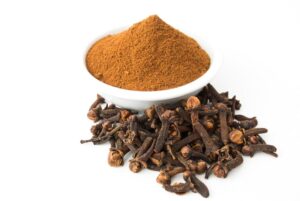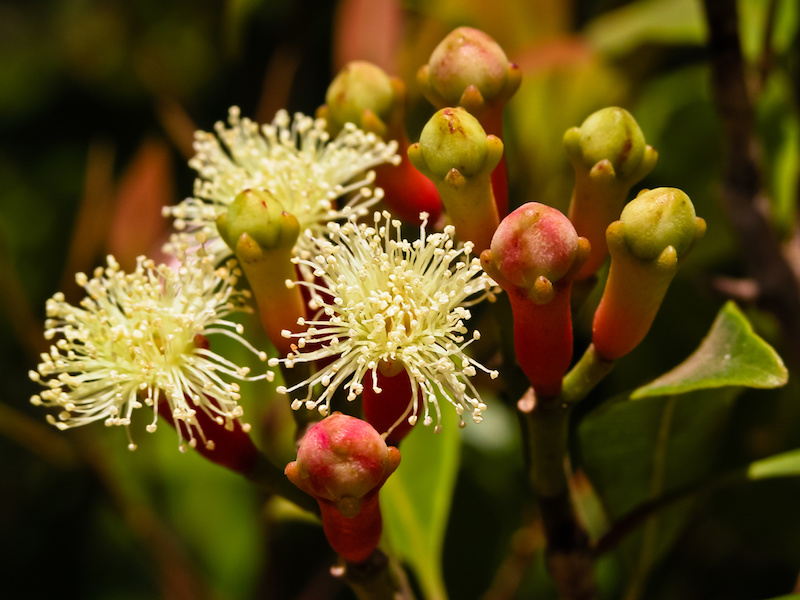Ayurvedic
Lavanga (Syzygium Aromaticum) Herb Ayurvedic Overview
Lavanga (Syzygium aromaticum) is the dried flower bud cultivated in many parts of the world like India, Pakistan, Sri Lanka, Tanzania, Africa, Madagascar. It contains volatile oils whose main component is Eugenol which has anti-inflammatory and antioxidant properties, reducing the risk of diseases such as arthritis and help in managing associated symptoms of joint-related disorders. The flower buds are collected twice a year in the month of October and February when they change color from green to crimson. Whole cloves are shaped like a small, reddish-brown spike, usually around 1 centimeter in length with a bulbous top. Lavanga can be used whole or ground, it has a very strong, pungent flavor and aroma.
Traditionally Lavanga (Syzygium aromaticum) is used in India as a mouth freshener. Due to its strong anti-fungal properties, it amazingly works in the management of acne and warts. According to Ayurveda, lavanga improves circulation, digestion, and metabolism. Due to its eugenol component, it effectively works in decreasing pain and fight infections. The oil of clove is applied on the head to relieve severe headaches, due to the ability to kill micro-organisms and helps to overcome common cold and cough.
Table of Contents
Scientific Classification of Lavanga (Syzygium Aromaticum):
- Kingdom: Plantae
- Class: Equisetopsida
- Order: Myrtales
- Family: Myrtaceae
- Genus: Syzygium
- Species: Aromaticum
Lavanga (Syzygium Aromaticum) Synonyms:
- Sanskrit: Devapuspa
- Assamese: Lavang, Lan, Long
- Bengali: Lavang
- English: Clove
- Gujrati: Lavang, Laving
- Hindi: Lavanga, Laung
- Kannada: Lavanga
- Kashmiri: Rung
- Malayalam: Karampu, Karayarnpoovu, Grampu
- Marathi: Lavang
- Oriya: Labanga
- Punjabi: Laung, Long
- Tamil: Kirambu, Lavangam
- Telugu: Lavangalu
- Urdu: Qarnful, Laung
Lavanga (Syzygium Aromaticum) Description:
 a) Macroscopic: The Flower bud of lavang is measuring about 10-17.5 mm in length. It is dark brown or dusty red and is consisting of a sub-cylindrical, slightly flattened, four-sided hypanthium.
a) Macroscopic: The Flower bud of lavang is measuring about 10-17.5 mm in length. It is dark brown or dusty red and is consisting of a sub-cylindrical, slightly flattened, four-sided hypanthium.
It is surmounted by four thick, divergent sepals and covered by unopened corolla consisting of four membranous imbricate petals, frequently detached, enclosing numerous incurved stamens and one erect style. The odor is strongly aromatic, taste, pungent, aromatic followed by slight tingling of the tongue.
b) Microscopic:The Transverse section of hypanthium shows epidermis and calyx teeth composed of straight-walled cells. The thick cuticle having large anomocytic stomata, hypanthium tissue spongy, clusters of calcium oxalate crystals varying in size from 6-20 µ in diameter. There is a small number of stone cells and prismatic crystals of calcium oxalate present in stalk and stamens.
Power: The powder of Lavanga is dark brown having fragments of parenchyma showing large oval, and schizolysigenous oil cavities. The fragments of anther walls with characteristic reticulated cells pollen grains.
Identity, Purity, and Strength of Lavanga (Syzygium Aromaticum):
- Foreign matter Not more than 2 percent, Appendix 2.2.2.
- Total Ash Not more than 7 percent, Appendix 2.2.3.
- Acid-insoluble ash Not more than 1 percent, Appendix 2.2.4.
- Alcohol-soluble extractive Not less than 3 percent, Appendix 2.2.6.
- Water-soluble extractive Not less than 9 percent, Appendix 2.2.7.
- Volatile oil Not less than 15 percent, Appendix 2.2.10
Chemical Constituents of Lavanga (Syzygium Aromaticum):
In Lavanaga, Volatile oil contains 16-21%, Phenol chiefly Eugenol is 80-88, acetyl eugenol is 10- 15%, tannins are 10-13%. Other than this it includes methyl furfural and dimethyl furfural.
Ayurvedic Properties and Action of Lavanga (Syzygium Aromaticum):
- Rasa (taste): Katu (pungent), Tikta (bitter)
- Guna (quality): Laghu (light to digest), Snigdha (unctuous, oily)
- Virya (potency): Seeta (cold)
- Vipaka (taste conversion after digestion): Katu (pungent)
- Karma: Kasahara, Shoolahara, Pachan, Ruchya, Deepan
- Effect on Tridosha: Kaphapittahara (Balances Kapha and Pitta Dosha)
Ayurvedic Formulation Made by Lavanga (Syzygium Aromaticum):
The most common Ayurvedic formulations of Lavanga (Syzygium aromaticum) are Lavangadi vati, Lavangadi churna, Himasagara Thailam, Bala Tailam, Kumaryasava, Drakshasava, Jambuasava.
Therapeutic Uses of Lavanga (Syzygium Aromaticum):
Lavanga is commonly used in Adhman, Chardi, Hikka, Shwasa, Trishna, Amlapitta, Deepan, Pachan, Ruchya, Kasa.
Dose of Lavanga (Syzygium Aromaticum):
- Lavanga Powder: 1-2 grams per day
- Clove Oil Dose: 1-2 drops
- Clove Buds: 2-3 per day.
Reference:
Ayurvedic Pharmacopeia of India.
For regular health updates, Please follow our Social Pages


